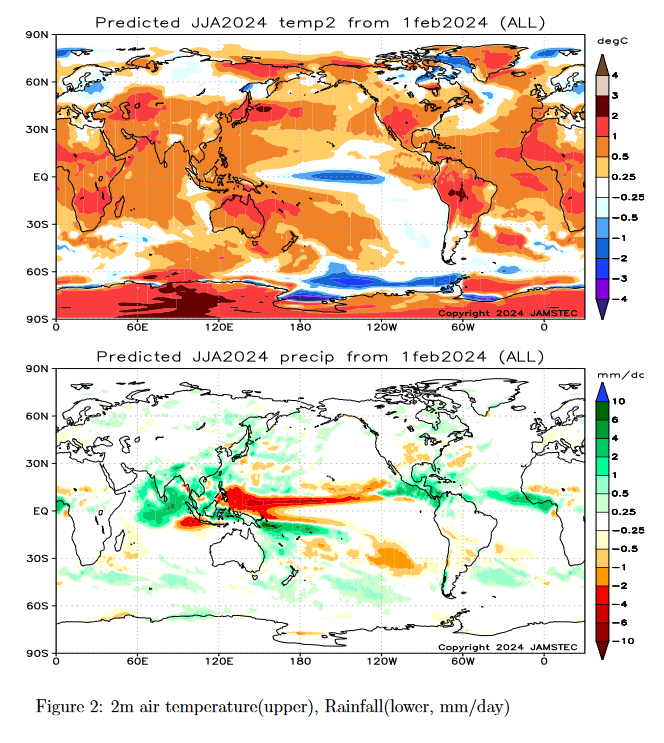
The Japan Agency for Marine-Earth Science and Technology, or JAMSTEC, is a Japanese national research institute for marine-earth science and technology
From the JAMSTEC Discussion:
“The recent observation suggests that the El Niño started to decay. The SINTEX-F ensemble mean predicts that the El Niño will decay and an El Niño Modoki will develop and persist at least until the next boreal spring. The model also predicts that a La Niña Modoki will occur in the boreal summer. However, there is a large uncertainty in the predicted amplitude.”
Although it is a World forecast, it includes a forecast for North America since North America is part of the World. One might try to compare it to the NOAA Outlook we published yesterday which can be accessed HERE.
First, we take a look at the forecasted sea surface temperature anomalies (SSTA). JAMSTEC starts by forecasting the SSTA and Nino 3.4 Index on the first day of the month and from there it usually takes their models about two weeks to produce their seasonal forecast. I received it from JAMSTEC on February 15 the same day as NOAA issued their Seasonal Update this month. The JAMSTEC model runs are based on conditions as of February 1, 2024. The NOAA Seasonal Outlook is based on conditions closer to the time when it is issued.
We have a full three-season forecast from JAMSTEC this month. We also have single-month forecasts for March, April and May 2024.
Let’s take a look.

| This shows their forecast of sea surface temperature anomalies at three points in time. Red is warm and is associated with El Nino if it occurs in the Nino 3.4 measurement areas. You can see the El Nino tongue of warm water extending from Peru to the west in the MAM image but look at that blob of warm water to the west i.e. by this point in time this has Modoki characteristics which impact the Walker circulation. JJA and SON show ENSO Neutral or La Nina.
JAMSTEC (and also NOAA) are showing very warm oceans in many parts of the world. I have written about that before. It raises questions about the reliability of our current approach to thinking about the ENSO Cycle. This is covered in another article that can be accessed HERE. But JAMSTEC is showing a relatively normal ocean off the coast of much of the U.S. which probably explains their strange forecast. JAMSTEC uses the same definition of Normal (climatology) as NOAA. JAMSTEC does a better job at characterizing La Ninas and El Ninos than NOAA. JAMSTEC provides me with a lot of other information that I do not include in my articles to keep them to a manageable size for readers. JAMSTEC has been having some computational issues with its model. From the email I received from them: “Because of changes to the library in our computer, this time we could not complete all members”. Two months ago they were not able to publish at all. I do not know how to assess their message to me. In November they upgraded their model from 12 members to 36. Their goal is to go to 108. On the website, the images indicate that all members were included. It is not possible to accurately estimate the current conditions. So the technique in ensemble models is to perturb the assumptions slightly for multiple model runs (or use different physics models for some runs) and take the average (mean) of the solutions. Each solution is called a member of the group of solutions for which the mean was taken. I am intrigued by the coincidence of this “change to the library in our computer” with their publication of this article. Based on the Japanese Culture they would not have released this forecast if they did not have confidence in it. |
Some Readers will have to click on “Read More” to read the rest of the article which you need to read to see the forecasts. I can only include a certain amount of material in the lede.
Then we look at three forecasts. As discussed earlier, JAMSTEC tries to work with meteorological seasons and this month it lines up perfectly.
Now we look at the three seasonal forecasts.

| The above covers March/April/May which is Spring.
“The SINTEX-F predicts that most parts of the globe will experience a warmer-than-normal condition in the boreal spring, except for most of the southeastern U.S.A., southern Argentina, and the Kamchatka Peninsula.” “As regards the rainfall in the boreal spring, a drier-than-normal condition is predicted for Mexico, Hawaii, Brazil, northern Australia, southern Africa, and the Philippines. In contrast, some parts of the U.S.A., some parts of Central America, the northern part of the South American Continent, the La Plata Basin, the southern part of Australia, some parts of central Africa, most of East Asia, and Indonesia will experience a wetter-than-normal condition.” “The model predicts that most of Japan will be warmer and some parts (e.g., Hokkaido, Kyushu, and Okinawa) will be wetter than normal in the spring.” |
| The above covers June/July/August 2024 which is Summer.
Here is the interpretation from the JAMSTEC discussion: “The model also predicts that most parts of the globe will experience a hotter-than-normal condition in the boreal summer, except for the northern part of Canada, some parts of Argentina, the northern part of Europe, and most of Russia.” “In the boreal summer (austral winter), a drier-than-normal condition is predicted for the central part of the U.S.A., the southern part of the South American Continent, the northern part of West Africa, some parts of Indonesia, and the southern part of the Philippines. In contrast, the eastern part of the North American Continent, Mexico, Central America, the northern part of the South American Continent, New Zealand, the eastern part of Australia, some parts of West Africa, India, Nepal, Bhutan, most of Indochina, most of Indonesia, the northern part of the Philippines, some parts of China, East Asia, and some parts of Russia will experience a wetter-than-normal condition.” “In the summer, most parts of Japan will be hotter and wetter than normal.” |

| The above covers September/October/November 2024 which is Fall or Autumn as you prefer.
JAMSTEC does not provide a commentary for the third map but the reader can interpret it themselves.
|
Now I am going to provide their single-month forecasts for March April, and May 2024.

| The above is the single month of March 2024. It is interesting as a world forecast but since the U.S. is part of the world it also provides a U.S. forecast. Notice the cold and wet Southeast for the U.S. |
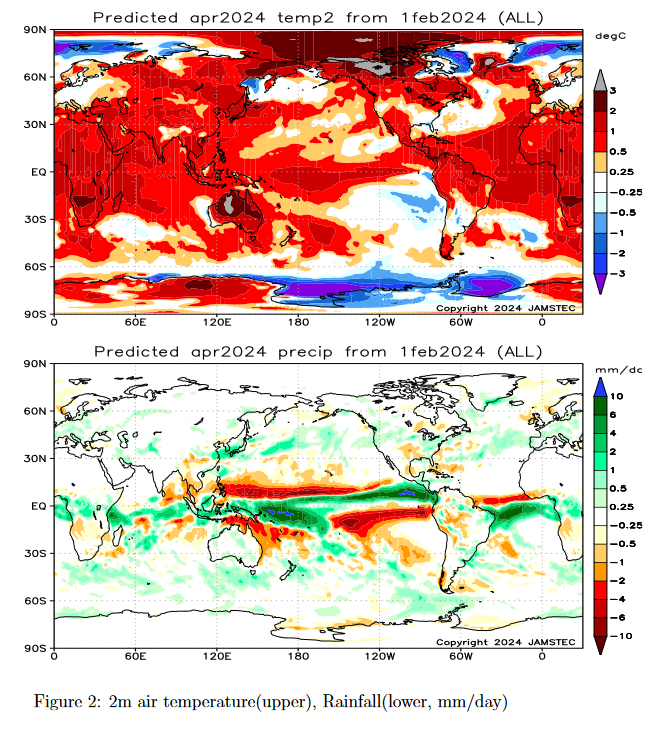
| The above is the single month of April 2024. It is a world forecast but you can clearly see the forecast for the U.S. The cool East moderates and the precipitation pattern changes a bit from the March forecast. |
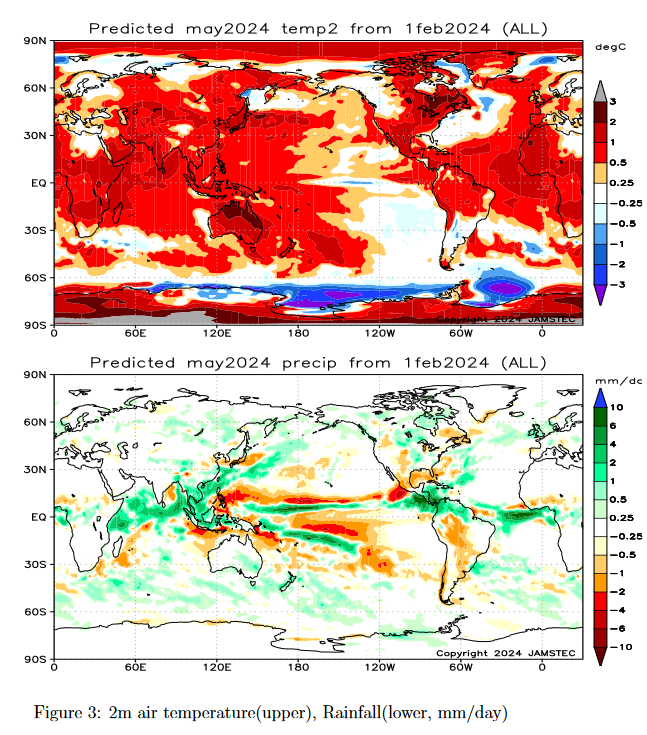
| The above is the single month of May, 2024. The temperature pattern seems to rotate with some normal temperatures in the West and the Southern Tier and Southeast are wet. |
Now we look at the key indices used by JAMSTEC in making their forecast. Perhaps I should have presented these first.
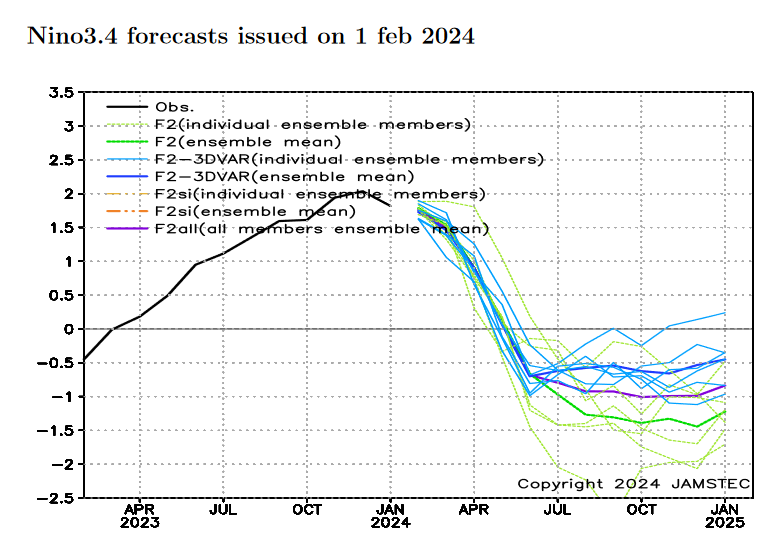
| This forecast is for a declining El Nino (Nino 3.4 peaking at 2.0). It is forecasting a fairly rapid decline in the strength of the El Nino 3.4 Index and a transition to La Nina. |
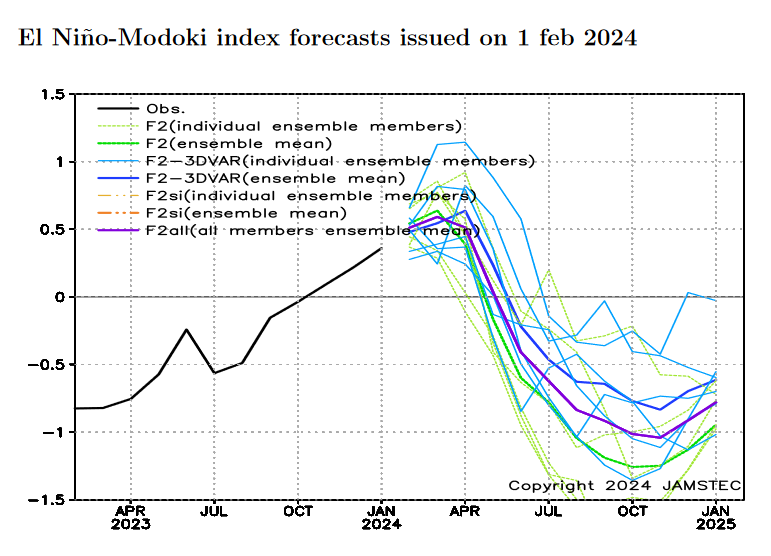
| I am showing the Modoki Index this month. As we move from winter to spring the Modoki Index suggests some shifting to the west of the Walker Circulation as the El Nino assumes some Modoki characteristics. This can explain the difference for NOAA in the forecasts by the CPC and their Proprietary Model. |
| We are having a Neutral IOD predicted through winter so there was no need to show the forecast. |
But
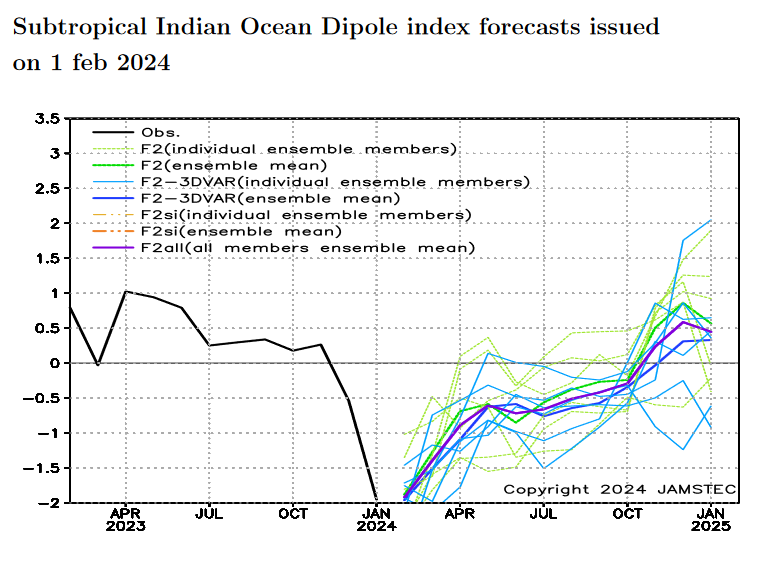
| We are having a Negative Subtropical IOD. THIS article might help explain what it means. I had difficulty understanding the impacts of a negative event as the article seems to focus on positive events. |
And here is the short JAMSTEC Discussion which I have already included with each of the seasonal forecast maps.
ENSO forecast:
The recent observation suggests that the El Niño started to decay. The SINTEX-F ensemble mean predicts that the El Niño will decay and an El Niño Modoki will develop and persist at least until the next boreal spring. The model also predicts that a La Niña Modoki will occur in the boreal summer. However, there is a large uncertainty in the predicted amplitude.
Indian Ocean forecast:
As predicted, the recent observation confirms the weak signal of the positive Indian Ocean Dipole, particularly the warmer-than-normal temperature in the western Indian Ocean. The SINTEX-F predicts that the positive Indian Ocean Dipole will disappear in the boreal spring, however the Indian Ocean Basin Mode, particularly strong anomalies in the western Indian Ocean, will persist through the boreal summer.
Regional forecast:
The SINTEX-F predicts that most parts of the globe will experience a warmer-than-normal condition in the boreal spring, except for most of the southeastern U.S.A., southern Argentina, and the Kamchatka Peninsula. The model also predicts that most parts of the globe will experience a hotter-than-normal condition in the boreal summer, except for the northern part of Canada, some parts of Argentina, the northern part of Europe, and most of Russia.
As regards the rainfall in the boreal spring, a drier-than-normal condition is predicted for Mexico, Hawaii, Brazil, northern Australia, southern Africa, and the Philippines. In contrast, some parts of the U.S.A., some parts of Central America, the northern part of the South American Continent, the La Plata Basin, the southern part of Australia, some parts of central Africa, most of East Asia, and Indonesia will experience a wetter-than-normal condition.
In the boreal summer (austral winter), a drier-than-normal condition is predicted for the central part of the U.S.A., the southern part of the South American Continent, the northern part of West Africa, some parts of Indonesia, and the southern part of the Philippines. In contrast, the eastern part of the North American Continent, Mexico, Central America, the northern part of the South American Continent, New Zealand, the eastern part of Australia, some parts of West Africa, India, Nepal, Bhutan, most of Indochina, most of Indonesia, the northern part of the Philippines, some parts of China, East Asia, and some parts of Russia will experience a wetter-than-normal condition.
The model predicts that most of Japan will be warmer and some parts (e.g., Hokkaido, Kyushu, and Okinawa) will be wetter than normal in the spring. In the summer, most parts of Japan will be hotter and wetter than normal.
–
| I hope you found this article interesting and useful |
